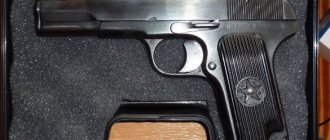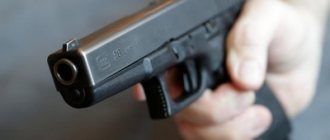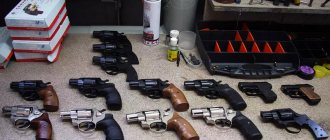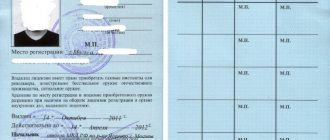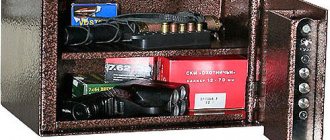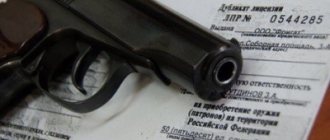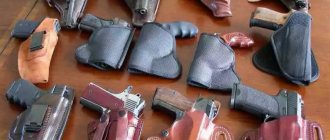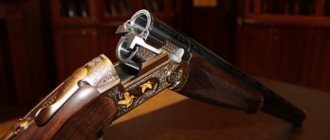○ Features of purchasing traumatic weapons
Not all citizens can purchase traumatic weapons, but only those who are over 18 years old. Persons for whom there is evidence that they:
- They have an outstanding criminal record.
- They were held administratively liable for violating public order.
- They have medical contraindications.
Other citizens have the opportunity to purchase self-defense weapons only after:
- They will undergo special courses.
- Obtain permission to purchase trauma equipment.
- will buy it.
- Register and receive a license to store and carry weapons.
✔ Registration of permission
After completing special courses, the citizen applies to the territorial police unit. Provides the necessary package of documents on the basis of which a permit to purchase weapons is issued:
- Statement.
- Copy of passport and TIN.
- Certificate or certificate of completion of special courses.
- Medical certificate.
- Four photographs, size 3 by 4.
- Documents for a safe or metal box for storing weapons.
- An inspection report on the installation site of a safe or metal box, drawn up by the district police officer.
✔ Completion of training
Special courses are conducted on the basis of specialized educational institutions. During the training period, laws and by-laws are studied that regulate the procedure for using traumatic weapons, the features of their storage and carrying.
During practical classes, skills in dealing with injuries are developed, as well as methods and techniques for providing first aid.
✔ Collection of documents
The list of documents that should additionally be submitted to the police officer responsible for the permitting system after purchasing a weapon includes:
- A duplicate of the permit with the store's mark on the sale of weapons.
- A set of spent cartridges in original packaging, which is included with the weapon.
- An insurance contract drawn up when purchasing trauma equipment.
- Receipt for payment of state duty.
✔ Obtaining permission to store and carry
The permit to purchase weapons is valid for six months. During this time, you need to have time to buy or otherwise acquire trauma equipment.
From the date of purchase, it is necessary to register the weapon with the police within two weeks.
One month is allotted for issuing a permit to store and carry traumatic weapons, from the date of its registration with the police. The validity period of the permit is set at five years.
Wearing rules
Before you buy a traumatic weapon, you must first obtain the appropriate permit from the licensing department. Immediately after purchase, the weapon must be registered, and its owner receives a license to carry and store traumatic weapons. However, the presence of such a document does not reduce the citizen’s share of responsibility either before the public or before the law. The rules for wearing, transporting and storing trauma equipment have been determined.
- All citizens, except those persons who are on the security staff of objects, are prohibited from wearing personal protective equipment in crowded places or in public places. To understand the rules, these two concepts are identical. These include: cafes, hospitals, schools, clubs.
- It is prohibited to install accessories on traumatic weapons. Thus, a silencer or an infrared night vision device will be illegal. It is understood that the traumatic weapon cannot be used as a weapon for hidden shooting.
- A citizen who is drunk has no right to carry a traumatic weapon. It doesn’t matter at all whether he used it or not. The very fact of having a weapon is already considered a valid reason and grounds for initiating a criminal case.
- The number of weapons per citizen is very limited. If wearing a traumatic device is not transportation, then one person is allowed to carry only two units.
The right to bear arms does not mean that they can be used whenever necessary. Trauma can be used if the life of a citizen or members of his family is truly in danger.
In addition, he does not have the right to use weapons immediately to hit a target. It is first necessary to loudly warn the attacker about the possibility of a shot, then fire one shot into the air and only then, taking into account that the distance to the target is at least one meter, use the weapon. Otherwise, the citizen himself will become the accused; this often happens in practice.
○ Difference between permits for acquisition, storage and carrying
Initially, the applicant for the acquisition of a traumatic weapon is given only a permit to purchase it. Weapons can be purchased from a specialized store or from an individual who legally owns them.
After checking the legality of the acquisition of weapons and checking them against the card index, if they were purchased secondhand, a permit to store and carry weapons is issued.
You cannot store or carry weapons with a permit to purchase them. This is illegal, for which there is liability!
Penalties for violations
Many people mistakenly assume that wearing a traumatic vehicle can be passed off as transporting it, so they are in no hurry to apply for a license at the OLRR. Looking ahead, we note that such a joke with the law backfires on them. All violations of the law related to weapons are closely monitored by law enforcement agencies and are punishable by serious fines.
The inspector will not bother to prove that it is the carrying and not the transportation of weapons that is taking place. But in the process of proving his innocence, a citizen will spend a lot of time and nerves, so we advise you to file a trauma report as required by law.
Fines for violating the current rules for storing traumatic weapons or carrying traumatic weapons start at 2,000 rubles. If the acquisition of weapons did not occur within the framework of the law, then the total amount of the fine consists of the penalty for the purchase and the fine for lack of a license.
The amount of the fine may exceed 5,000 rubles, but even payment of the fine does not limit the punishment. In some cases, weapons acquired illegally or stored with obvious violations are confiscated free of charge. Ammunition for this type of weapon is also confiscated. But despite all the severity of the law, a citizen will not be subject to criminal prosecution for a single violation of the procedure for storing or carrying injuries.
○ Responsibility for illegal storage and carrying of traumatic weapons
Current legislation provides for liability if there is no license for a traumatic pistol.
✔ Administrative responsibility
Article 20.8 of the Code of Administrative Offenses of the Russian Federation establishes a number of sanctions against citizens for:
"4. Violation of the rules for storing, carrying or destroying weapons and ammunition for them by citizens, with the exception of the case provided for in part 4.1 of this article,
- entails the imposition of an administrative fine in the amount of five hundred to two thousand rubles or deprivation of the right to acquire and store or store and carry weapons for a period of six months to one year.
4.1. Carrying a firearm by a person in a state of intoxication - entails the imposition of an administrative fine on citizens in the amount of two thousand to five thousand rubles with or without confiscation of the weapon and ammunition for it, or deprivation of the right to acquire and store or store and carry weapons for a period from one year to two years with or without confiscation of weapons and ammunition.
4.2. Failure of a person carrying a firearm to comply with the legal requirement of a police officer to undergo a medical examination for intoxication - entails deprivation of the right to acquire and store or store and carry weapons for a period of one to two years with or without confiscation of weapons and ammunition. .
6. Illegal acquisition, sale, transfer, storage, transportation or carrying of civilian smooth-bore firearms and firearms of limited destruction - entails the imposition of an administrative fine on citizens in the amount of three thousand to five thousand rubles with confiscation of weapons and ammunition for them or administrative arrest for a term of five to fifteen days with confiscation of weapons and ammunition.”
✔ Criminal liability
Article 222 of the Criminal Code of the Russian Federation also provides for various criminal penalties, which depend on the specific situation. So:
"4. Illegal sale of civilian firearms smooth-bore long-barreled weapons, firearms of limited destruction, gas weapons, edged weapons, including throwing weapons - is punishable by compulsory labor for a term of up to four hundred eighty hours, or correctional labor for a term of one to two years, or restriction freedom for a term of up to two years, or forced labor for a term of up to two years, or arrest for a term of three to six months, or imprisonment for a term of up to two years with a fine of up to eighty thousand rubles or in the amount of wages or other income convicted for a period of up to six months or without it.”
Storing trauma products
Traumatic weapons, like hunting weapons, must be stored in a special safe. This requirement is dictated solely by safety.
- Firstly, the safe will provide secure storage and prevent free access to weapons, for example, by children.
- Secondly, an iron safe will protect cartridges and weapons from accidental fire. The danger is that during a fire the cartridges will spontaneously explode.
The safe must not only close, but also have a locking mechanism. The compliance of the storage location with safety requirements is checked by the local inspector, who submits a report to the licensing and permitting department. When a citizen begins to collect a package of documents to obtain a license, a report from the local police officer is attached.
It must be remembered that the place where the weapon is stored must coincide with the place of registration of its owner. The rules for storing traumatic weapons are regulated by government decree No. 814, which was published back in 1998. In the new edition, many points have been changed to be more relevant.
For example, licensing issues were transferred from the internal affairs bodies to the service of the Russian Guard troops. According to this document, only pneumatic weapons can be stored arbitrarily. Other types require special permission and a room equipped with a safe.
Transportation of trauma (legal) on a train
Andrei hung up complaint forms regarding protocols for transporting weapons, for which we thank him very much.
https://forum.guns.ru/forummessage/6/1466464.html
Very, very useful thing.
Page 3
Page 4
Page 5
Here is an example of how some gun laws are reduced to minimal effect.
In the USA, since 1934, there has been a law restricting the circulation of rifles shorter than 16 inches, automatic shooting, etc. Anything shorter requires an NFA/AOW permit/license, or is completely prohibited in some states. Basically, hemorrhoids.
– at first, the licensing system stipulated that guns without a vertical handle and butt would fall under the “pistol” category.
- then we agreed that rifles like M16/M4/AR would also be pistols, even with a spring bushing, due to their unique design. – then they challenged the ban on all vertical handles and received permission for an angled handle (for example, Magpul AFG). – further, the manufacturer of the fire transfer frame received approval for the design, where it can be moved to the 3rd position (without automatic fire) – even earlier, automatic fire due to recoil and hand support (bump-fire/slide fire) was allowed – recently the smart people from SIG received approval for a “hand rest” (SIG brace), which is essentially a stock for shotguns shorter than 16 inches. Then they received confirmation that no one forbids using this “prop” as a butt.
In total, almost all bans on carrying short guns were legal
bypassed.
Page 6
Source: https://ru-guns.livejournal.com/1898253.html
If the permit is refused
If all conditions provided by law are met, obtaining a license will not take a long time. To speed up the procedure somewhat, you can contact specialized commercial centers that organize the collection of documents for a license.
However, the absolute grounds for refusal to issue a special permit are:
- age less than 21 years, there are contraindications related to health conditions or the exam has not been passed;
- persons who do not have a specific place of residence;
- there are violations of hunting rules;
- a conviction for committing an intentional crime of any nature has entered into legal force. The type of punishment does not play a significant role in this case, while at the same time, only the outstanding criminal record matters for refusal;
- committing, within 12 months by the time of applying for a license, at least two administrative offenses related to an encroachment on administrative order (or public order);
- prisoners who, at the time of applying for permission, are serving a sentence of imprisonment for committing a crime.
For example, all the necessary documents sufficient to obtain a permit have been collected. But the appeal was later, say, a year later. The issuance of a license will be refused due to an expired medical report (valid for 1 year).
If the issuance of a license is refused unreasonably, the actions of LRO employees are appealed to the court. Such cases are isolated, since an exhaustive list of requirements for the recipient of a license eliminates any ambiguities in the application of the law.
Do I need a permit for a traumatic pistol?
Yes, in order to legally purchase, store, carry and use trauma equipment for its intended purpose, you must obtain permission to do so.
First of all, any person purchasing a weapon must understand that a pistol is a means of defense - such weapons can only be used in exceptional cases, that is, when there is reason to believe that something really threatens the life or health of the owner of the weapon.
There are two types of licenses:
- for the purchase of weapons;
- for its storage and wearing.
You need to know that if you don’t have the first one, they won’t sell you a gun, and if you don’t have the second one, you can be held accountable. More on this later.
Vendetta
Vendetta - this domestic licensed copy of the Italian INNA pistol inherited all its pros and cons from the original. The widespread use of composite materials facilitates the design, but also affects reliability. In addition, the unreasonably large ammunition capacity—10 rounds—negates the advantages of polymer parts.
The muzzle energy of about 80 Joules with a 9 mm caliber provides more than sufficient stopping effect, and the length of the barrel allows you to confidently hit the target at distances comparable to combat models. Such characteristics are largely redundant for self-defense weapons and do not at all reduce the cost. However, this model is perfect for shooting at a shooting range.
The legislative framework
The main law regulating legal relations in the field of storing and carrying weapons is Federal Law No. 150. It lists all types of weapons. However, traumatic pistols and rifles as such are not mentioned among them. At the same time, the document mentions civilian self-defense weapons, which are equipped with cartridges that have a “traumatic effect.” This type of weapon is considered traumatic.
In practice, it is customary to distinguish several categories of such devices:
- firearms without a barrel;
- gas;
- firearms of limited damage (also referred to as OOOP).
Trauma must meet several criteria simultaneously:
- muzzle energy up to 91 J;
- Only traumatic cartridges are used;
- can only be used for self-defense;
- the composition can include a maximum of 10 cartridges.
Despite the definition of “traumatic weapon,” these types of pistols and revolvers can not only cause bodily harm, but also kill a person when fired at close range into vital organs and parts of the body.
Therefore, the concepts of “traumatic” and “non-lethal” can mislead the consumer regarding the properties of such types of weapons. Despite the fact that traumatism is indeed intended only for self-defense, this does not exclude the possibility of injury to a person or animal. Thus, from a technical point of view, the possibility (threat) of causing serious harm, including death, always remains.
Procedure for obtaining a license
Travmat is a type of firearms or revolvers designed to fire traumatic bullets. Obtaining a license is a prerequisite for owning, using and storing such a pistol. If all these actions are carried out without special permits, then this will already be a violation of the law.
The acquisition of a traumatic weapon for self-defense must be approached consciously, with a full understanding of the responsibility that you will assume.
So, when you have finally made your decision, be prepared for the fact that before purchasing the traumatic pistol itself, you will need:
- undergo training in order to be able to use it correctly, store it, and also provide first aid, if necessary;
- obtain permission for the purchase itself;
- pass a medical commission, the opinion of a narcologist and a psychiatrist is especially important (the certificate is valid for one year, and the commission is required to pass annually, in case of gun ownership);
- obtain a license to store, carry and use it;
- purchase a reliable safe specifically for storing it.
